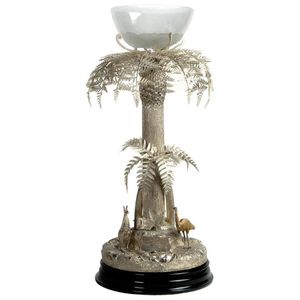A fine and important sterling silver presentation palm-tree centrepiece by Joachim Matthias Wendt of Adelaide, Australian, circa 1880, Inscribed ?Presented to The Mayoress of Adelaide Mrs J. Lavington Bonython, by the citizens in recognition of many graceful acts during the municipal years 1912-1913?, 56 cm high, stamped on the back of the base J M Wendt Adelaide and the later presentation plaque also stamped for the same maker., sold with a later frosted and clear Lalique glass bowl that is not associated with the piece. Provenance: Presented to Lady Jean Bonython OBE in April 1914, Thence by descent, Literature, 'Concerning People'. The Register, 24 April 1914, p.10, 'Mr Lavington Bonython', The Advertiser, 24 April 1914, p. 16, 'A Portrait of Mr Lavington Bonython', The Advertiser, 17 April 1914, p. 11, 'Presentation to the Mayor', The Register, 28 October 1913, p.6. The Bonython Epergne, by J.M. Wendt, Australian, circa 1880, In 1883, around the time when this epergne was produced, large deposits of silver had been discovered at Broken Hill. The silver-rush had a two-fold effect: it created a flourishing new class of wealthy new landowners in the colony, and also it increased the supply of the material, signalling a renaissance in the production of colonial silver presentation pieces., By the late 1880s, the Danish emigre Joachim Matthias Wendt (1830-1917), watchmaker and jeweller, had opened his third retail store in Broken Hill, and was well positioned to profit from the new discovery. By the time the Bonython Epergne was produced, the ?Jeweller to his Royal Highness? had already been commissioned a number of important presentation pieces, including the 1870 salver (National Gallery of Australia, Canberra), The George Henry Farr epergne (Art Gallery of South Australia, Adelaide), and had returned from the 1878 Paris Exposition Universelle with prizes for his decorative epergnes.1, These epergnes were at times commissioned or recycled as sumptuous gifts for honoured citizens. Sir John Lavington Bonython Jnr. (1875-1960) was as distinguished as they came in Adelaide at the turn of the century. Born into a wealthy, powerful and philanthropic family, his father, Sir John Langdon Bonython (1848-1939), was sole proprietor of The Advertiser by 1894 and generous benefactor to the city. In 1912, Sir Bonython Jnr. became Adelaide?s youngest Mayor of Adelaide. Two years later, he and his wife, Lady Jean Bonython, were celebrated for their services to the city., Although precious mayoral gifts are not unknown - William Edwards? 1860 silver claret jug for George Wragge is well documented2 - neither were they very common. Scarcer still were gifts to mayoresses. A committee, chaired by Sir Charles Goode, was appointed to select the desirable objects. However, it is possible, even likely, that the most influential committee member in the selection of the epergne was Hermann Koeppen-Wendt, stepson of J.M. Wendt and partner in the J.M. Wendt business.3, In 1914, upon completion of Bonython?s Jnr.?s final term as Mayor, ?some tangible tokens? were presented to the public servants in a ceremony at the Town Hall.4 The Mayor was presented with a portrait by the English born George Webb (Town Hall Collection, Adelaide). Mrs. Bonython?s earned ?unstinted affection and esteem of all sections of the community by her unfailing tact and graciousness as Mayoress5 were noted and she was presented with this beautiful object., A large and exquisite epergne, produced using frosted silver, a complex technique that leaves the surface with a coarse textured finish, is an excellent example of some of the finest workmanship to come out of South Australia. The ground on which the kangaroo and emu stand is modelled with naturalistic expression, and even if the animals are somewhat stocky, they, like the palm trees and delicately applied fronds, are presented with a detailed finish that attests to the maker?s intimate knowledge of the native flora and fauna., T
You must be a subscriber, and be logged in to view price and dealer details.
Subscribe Now to view actual auction price for this item
When you subscribe, you have the option of setting the currency in which to display prices to $Au, $US, $NZ or Stg.
This item has been sold, and the description, image and price are for reference purposes only.
- Sterling Silver - Sterling silver is a mixture of 92.5% pure silver and 7.5% of another metal, usually copper. Fine silver is 99.9% pure silver, and is relatively soft and the addition of the very small amount of copper gives the metal enough strength and hardness to be worked into jewellery, decorative and household objects.
- Circa - A Latin term meaning 'about', often used in the antique trade to give an approximate date for the piece, usually considered to be five years on either side of the circa year. Thus, circa 1900 means the piece was made about 1900, probably between 1895 and 1905. The expression is sometimes abbreviated to c.1900.
- Salver - A plate or tray used for the formal offering of food, drink, letters or visiting cards, usually of silver plate, silver or silver-gilt. Large, heavy, oblong or oval silver salvers evolved into what we know as trays in the 18th century. Small, flat salvers are known as waiters.
This item has been included into following indexes:




